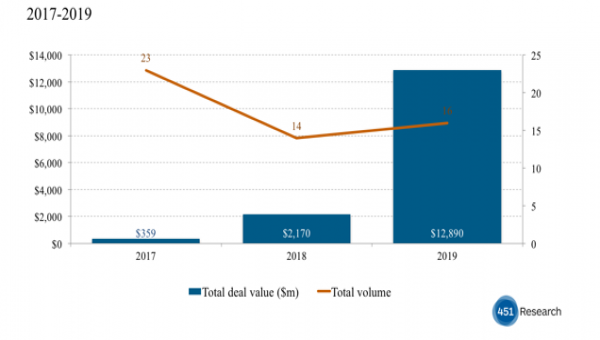by Michael Hill
Hungry for more than geographic expansion, food delivery companies are driving up deal spending as they look beyond the usual targets for acquisitions. While buyers remain busy consolidating a fragmented market, they are making additional bets on the technology behind those services and other offerings that could expand their addressable market.
According to 451 Research‘s M&A KnowledgeBase, the total value of deals done by food delivery companies rose to nearly $13bn from just $359m two years earlier, thanks in large part to a pair of blockbuster transactions – TakeAway’s $8.3bn reach for Just Eat and Delivery Hero’s $4bn pickup of Woowa Brothers. But while those moves were motivated by geography and increased market share, other, less showy deals showcased increased buyer imagination.
Take DoorDash’s acquisition in August of Scotty Labs. The target develops remote-controlled autonomous vehicle software for businesses that DoorDash could eventually use to power its own fleet of autonomous delivery vehicles. Two months earlier, there was Indonesia-based food delivery app maker Go-Jek’s purchase of AirCTO, a Bangalore-based provider of recruitment software that uses artificial intelligence to screen prospective job candidates.
In earlier years, all deals done by delivery companies were pickups of smaller competitors. According to M&A KnowledgeBase data, in 2017, for example, all 23 of the acquisitions by food delivery companies were for fellow delivery services. In fact, 17 of those transactions were announced by BiteSquad in a single October day in the name of expanding its services to more than 30 new US metro areas.
However, 2019 wasn’t the first time these buyers stretched beyond their core market. GrubHub’s 2018 pickup of mobile payments and loyalty services provider LevelUp, for instance, as we discussed in a report on the deal, took the buyer beyond food delivery with technology that should enable it to offer more commerce software and services to restaurants just as those businesses are investing there. Indeed, as the food delivery market continues to consolidate, those who maintain a seat at the table will likely be those who have an appetite for expanding their addressable market.
Figure 1: Food delivery buyer volume and value

